Report: Employee Relations Analysis at CabinetCo - [Course Name/Code]
VerifiedAdded on 2023/01/11
|13
|4117
|87
Report
AI Summary
This report provides an analysis of the employee relations at CabinetCo, a kitchen unit manufacturer based in South East Melbourne, Australia, employing 200 individuals. The report delves into the theoretical frameworks of unitarist, radical, and pluralist perspectives to understand workplace dynamics, conflict resolution, and the role of unions. It examines the evolution of employee-management relationships, tracing changes from the industrial revolution to post-World War II, and the impact of these changes on voice communication within the company. The report highlights the shift in CabinetCo's employee relations following its acquisition by a US-based organization, emphasizing the negative impact on Australian employees due to perceived unfair treatment and communication barriers. The analysis covers how the company's current management style impacts employee relations and provides recommendations for improving communication and fostering a more positive work environment.
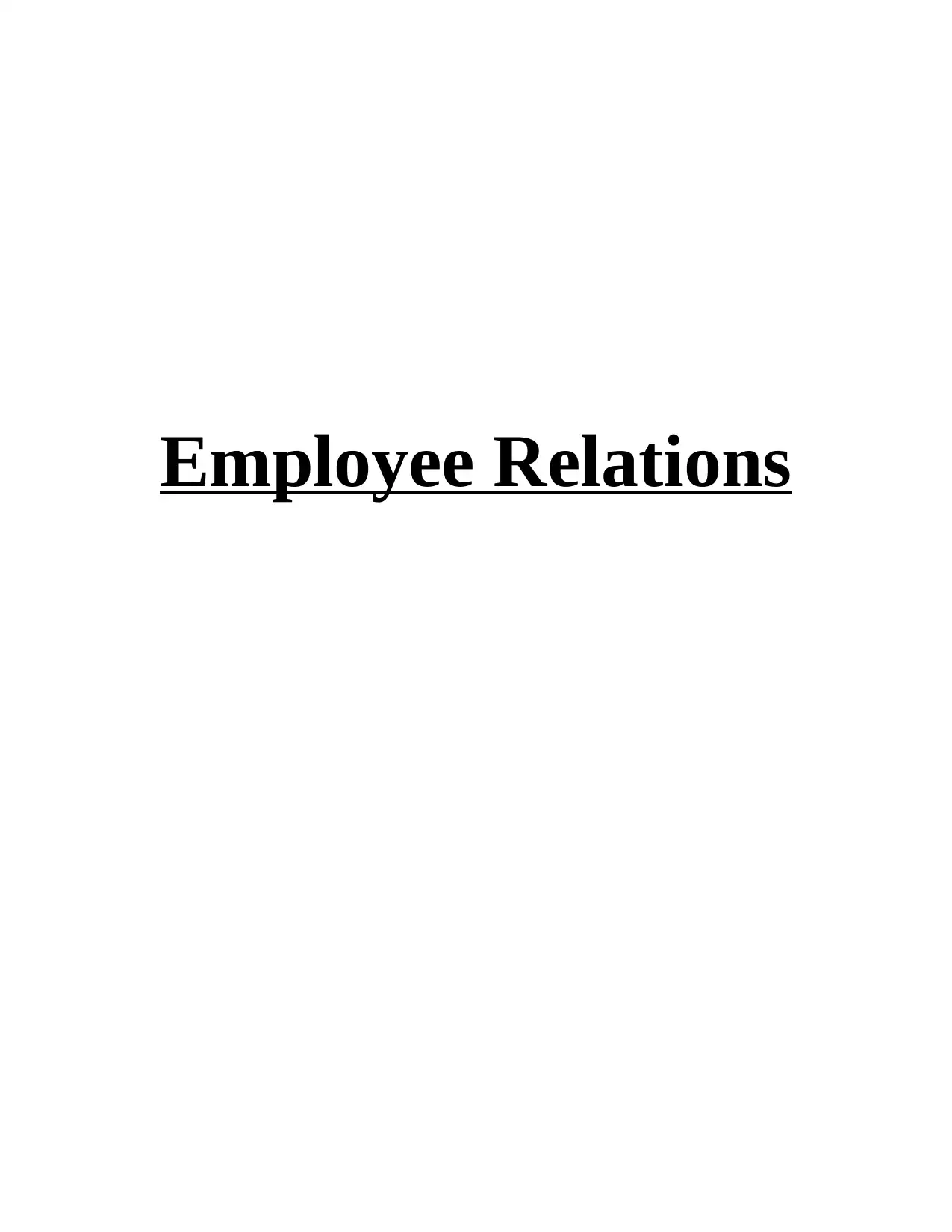
Employee Relations
Paraphrase This Document
Need a fresh take? Get an instant paraphrase of this document with our AI Paraphraser
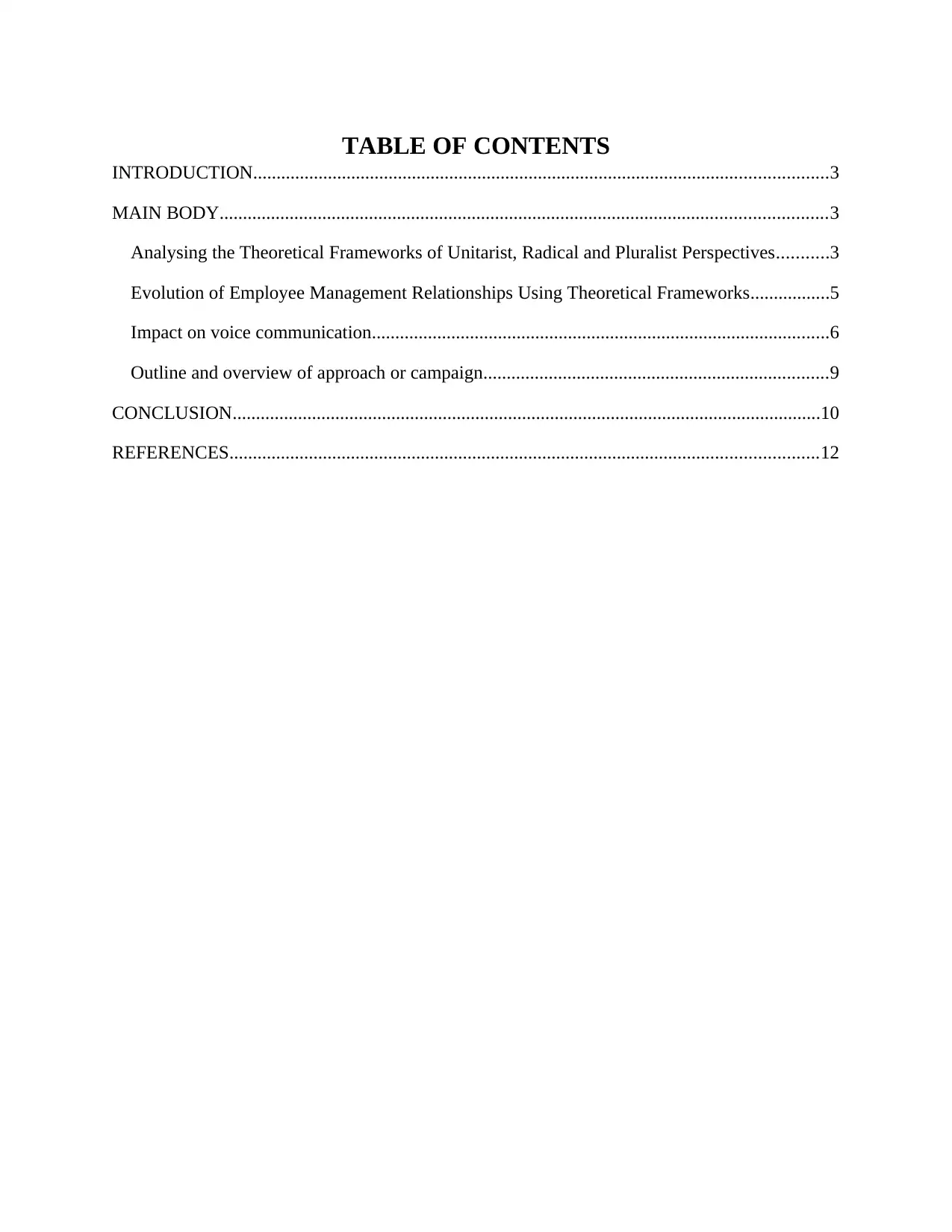
TABLE OF CONTENTS
INTRODUCTION...........................................................................................................................3
MAIN BODY..................................................................................................................................3
Analysing the Theoretical Frameworks of Unitarist, Radical and Pluralist Perspectives...........3
Evolution of Employee Management Relationships Using Theoretical Frameworks.................5
Impact on voice communication..................................................................................................6
Outline and overview of approach or campaign..........................................................................9
CONCLUSION..............................................................................................................................10
REFERENCES..............................................................................................................................12
INTRODUCTION...........................................................................................................................3
MAIN BODY..................................................................................................................................3
Analysing the Theoretical Frameworks of Unitarist, Radical and Pluralist Perspectives...........3
Evolution of Employee Management Relationships Using Theoretical Frameworks.................5
Impact on voice communication..................................................................................................6
Outline and overview of approach or campaign..........................................................................9
CONCLUSION..............................................................................................................................10
REFERENCES..............................................................................................................................12
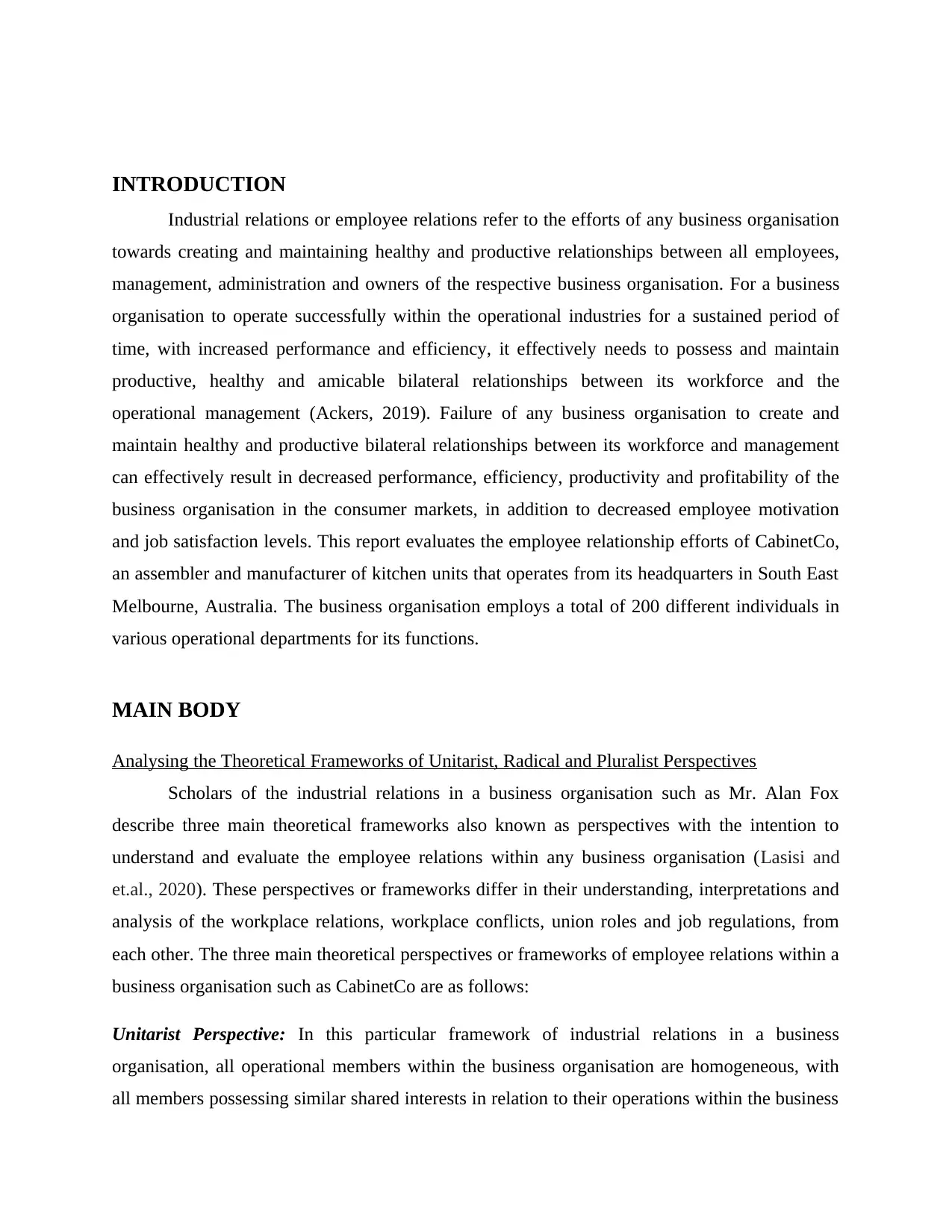
INTRODUCTION
Industrial relations or employee relations refer to the efforts of any business organisation
towards creating and maintaining healthy and productive relationships between all employees,
management, administration and owners of the respective business organisation. For a business
organisation to operate successfully within the operational industries for a sustained period of
time, with increased performance and efficiency, it effectively needs to possess and maintain
productive, healthy and amicable bilateral relationships between its workforce and the
operational management (Ackers, 2019). Failure of any business organisation to create and
maintain healthy and productive bilateral relationships between its workforce and management
can effectively result in decreased performance, efficiency, productivity and profitability of the
business organisation in the consumer markets, in addition to decreased employee motivation
and job satisfaction levels. This report evaluates the employee relationship efforts of CabinetCo,
an assembler and manufacturer of kitchen units that operates from its headquarters in South East
Melbourne, Australia. The business organisation employs a total of 200 different individuals in
various operational departments for its functions.
MAIN BODY
Analysing the Theoretical Frameworks of Unitarist, Radical and Pluralist Perspectives
Scholars of the industrial relations in a business organisation such as Mr. Alan Fox
describe three main theoretical frameworks also known as perspectives with the intention to
understand and evaluate the employee relations within any business organisation (Lasisi and
et.al., 2020). These perspectives or frameworks differ in their understanding, interpretations and
analysis of the workplace relations, workplace conflicts, union roles and job regulations, from
each other. The three main theoretical perspectives or frameworks of employee relations within a
business organisation such as CabinetCo are as follows:
Unitarist Perspective: In this particular framework of industrial relations in a business
organisation, all operational members within the business organisation are homogeneous, with
all members possessing similar shared interests in relation to their operations within the business
Industrial relations or employee relations refer to the efforts of any business organisation
towards creating and maintaining healthy and productive relationships between all employees,
management, administration and owners of the respective business organisation. For a business
organisation to operate successfully within the operational industries for a sustained period of
time, with increased performance and efficiency, it effectively needs to possess and maintain
productive, healthy and amicable bilateral relationships between its workforce and the
operational management (Ackers, 2019). Failure of any business organisation to create and
maintain healthy and productive bilateral relationships between its workforce and management
can effectively result in decreased performance, efficiency, productivity and profitability of the
business organisation in the consumer markets, in addition to decreased employee motivation
and job satisfaction levels. This report evaluates the employee relationship efforts of CabinetCo,
an assembler and manufacturer of kitchen units that operates from its headquarters in South East
Melbourne, Australia. The business organisation employs a total of 200 different individuals in
various operational departments for its functions.
MAIN BODY
Analysing the Theoretical Frameworks of Unitarist, Radical and Pluralist Perspectives
Scholars of the industrial relations in a business organisation such as Mr. Alan Fox
describe three main theoretical frameworks also known as perspectives with the intention to
understand and evaluate the employee relations within any business organisation (Lasisi and
et.al., 2020). These perspectives or frameworks differ in their understanding, interpretations and
analysis of the workplace relations, workplace conflicts, union roles and job regulations, from
each other. The three main theoretical perspectives or frameworks of employee relations within a
business organisation such as CabinetCo are as follows:
Unitarist Perspective: In this particular framework of industrial relations in a business
organisation, all operational members within the business organisation are homogeneous, with
all members possessing similar shared interests in relation to their operations within the business
⊘ This is a preview!⊘
Do you want full access?
Subscribe today to unlock all pages.

Trusted by 1+ million students worldwide
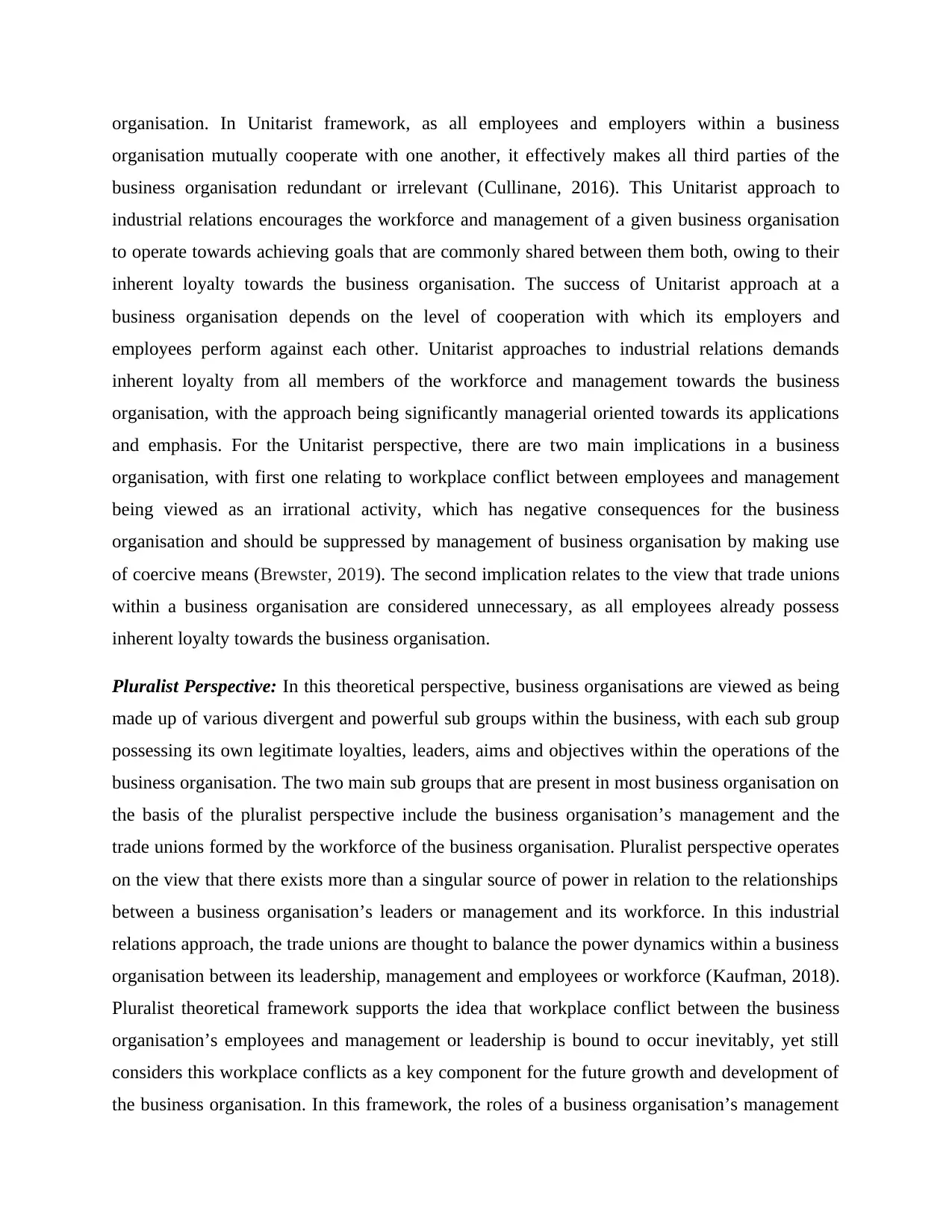
organisation. In Unitarist framework, as all employees and employers within a business
organisation mutually cooperate with one another, it effectively makes all third parties of the
business organisation redundant or irrelevant (Cullinane, 2016). This Unitarist approach to
industrial relations encourages the workforce and management of a given business organisation
to operate towards achieving goals that are commonly shared between them both, owing to their
inherent loyalty towards the business organisation. The success of Unitarist approach at a
business organisation depends on the level of cooperation with which its employers and
employees perform against each other. Unitarist approaches to industrial relations demands
inherent loyalty from all members of the workforce and management towards the business
organisation, with the approach being significantly managerial oriented towards its applications
and emphasis. For the Unitarist perspective, there are two main implications in a business
organisation, with first one relating to workplace conflict between employees and management
being viewed as an irrational activity, which has negative consequences for the business
organisation and should be suppressed by management of business organisation by making use
of coercive means (Brewster, 2019). The second implication relates to the view that trade unions
within a business organisation are considered unnecessary, as all employees already possess
inherent loyalty towards the business organisation.
Pluralist Perspective: In this theoretical perspective, business organisations are viewed as being
made up of various divergent and powerful sub groups within the business, with each sub group
possessing its own legitimate loyalties, leaders, aims and objectives within the operations of the
business organisation. The two main sub groups that are present in most business organisation on
the basis of the pluralist perspective include the business organisation’s management and the
trade unions formed by the workforce of the business organisation. Pluralist perspective operates
on the view that there exists more than a singular source of power in relation to the relationships
between a business organisation’s leaders or management and its workforce. In this industrial
relations approach, the trade unions are thought to balance the power dynamics within a business
organisation between its leadership, management and employees or workforce (Kaufman, 2018).
Pluralist theoretical framework supports the idea that workplace conflict between the business
organisation’s employees and management or leadership is bound to occur inevitably, yet still
considers this workplace conflicts as a key component for the future growth and development of
the business organisation. In this framework, the roles of a business organisation’s management
organisation mutually cooperate with one another, it effectively makes all third parties of the
business organisation redundant or irrelevant (Cullinane, 2016). This Unitarist approach to
industrial relations encourages the workforce and management of a given business organisation
to operate towards achieving goals that are commonly shared between them both, owing to their
inherent loyalty towards the business organisation. The success of Unitarist approach at a
business organisation depends on the level of cooperation with which its employers and
employees perform against each other. Unitarist approaches to industrial relations demands
inherent loyalty from all members of the workforce and management towards the business
organisation, with the approach being significantly managerial oriented towards its applications
and emphasis. For the Unitarist perspective, there are two main implications in a business
organisation, with first one relating to workplace conflict between employees and management
being viewed as an irrational activity, which has negative consequences for the business
organisation and should be suppressed by management of business organisation by making use
of coercive means (Brewster, 2019). The second implication relates to the view that trade unions
within a business organisation are considered unnecessary, as all employees already possess
inherent loyalty towards the business organisation.
Pluralist Perspective: In this theoretical perspective, business organisations are viewed as being
made up of various divergent and powerful sub groups within the business, with each sub group
possessing its own legitimate loyalties, leaders, aims and objectives within the operations of the
business organisation. The two main sub groups that are present in most business organisation on
the basis of the pluralist perspective include the business organisation’s management and the
trade unions formed by the workforce of the business organisation. Pluralist perspective operates
on the view that there exists more than a singular source of power in relation to the relationships
between a business organisation’s leaders or management and its workforce. In this industrial
relations approach, the trade unions are thought to balance the power dynamics within a business
organisation between its leadership, management and employees or workforce (Kaufman, 2018).
Pluralist theoretical framework supports the idea that workplace conflict between the business
organisation’s employees and management or leadership is bound to occur inevitably, yet still
considers this workplace conflicts as a key component for the future growth and development of
the business organisation. In this framework, the roles of a business organisation’s management
Paraphrase This Document
Need a fresh take? Get an instant paraphrase of this document with our AI Paraphraser
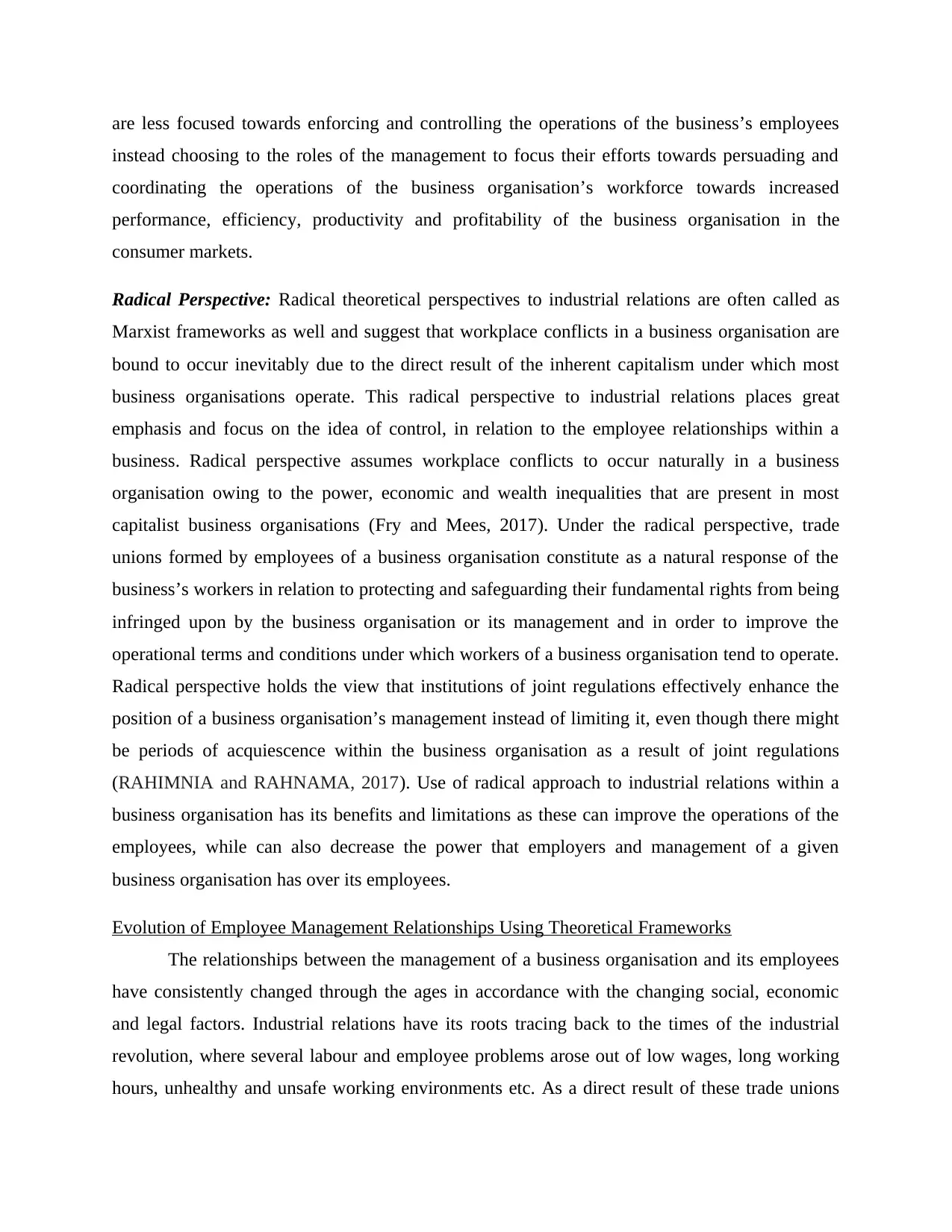
are less focused towards enforcing and controlling the operations of the business’s employees
instead choosing to the roles of the management to focus their efforts towards persuading and
coordinating the operations of the business organisation’s workforce towards increased
performance, efficiency, productivity and profitability of the business organisation in the
consumer markets.
Radical Perspective: Radical theoretical perspectives to industrial relations are often called as
Marxist frameworks as well and suggest that workplace conflicts in a business organisation are
bound to occur inevitably due to the direct result of the inherent capitalism under which most
business organisations operate. This radical perspective to industrial relations places great
emphasis and focus on the idea of control, in relation to the employee relationships within a
business. Radical perspective assumes workplace conflicts to occur naturally in a business
organisation owing to the power, economic and wealth inequalities that are present in most
capitalist business organisations (Fry and Mees, 2017). Under the radical perspective, trade
unions formed by employees of a business organisation constitute as a natural response of the
business’s workers in relation to protecting and safeguarding their fundamental rights from being
infringed upon by the business organisation or its management and in order to improve the
operational terms and conditions under which workers of a business organisation tend to operate.
Radical perspective holds the view that institutions of joint regulations effectively enhance the
position of a business organisation’s management instead of limiting it, even though there might
be periods of acquiescence within the business organisation as a result of joint regulations
(RAHIMNIA and RAHNAMA, 2017). Use of radical approach to industrial relations within a
business organisation has its benefits and limitations as these can improve the operations of the
employees, while can also decrease the power that employers and management of a given
business organisation has over its employees.
Evolution of Employee Management Relationships Using Theoretical Frameworks
The relationships between the management of a business organisation and its employees
have consistently changed through the ages in accordance with the changing social, economic
and legal factors. Industrial relations have its roots tracing back to the times of the industrial
revolution, where several labour and employee problems arose out of low wages, long working
hours, unhealthy and unsafe working environments etc. As a direct result of these trade unions
instead choosing to the roles of the management to focus their efforts towards persuading and
coordinating the operations of the business organisation’s workforce towards increased
performance, efficiency, productivity and profitability of the business organisation in the
consumer markets.
Radical Perspective: Radical theoretical perspectives to industrial relations are often called as
Marxist frameworks as well and suggest that workplace conflicts in a business organisation are
bound to occur inevitably due to the direct result of the inherent capitalism under which most
business organisations operate. This radical perspective to industrial relations places great
emphasis and focus on the idea of control, in relation to the employee relationships within a
business. Radical perspective assumes workplace conflicts to occur naturally in a business
organisation owing to the power, economic and wealth inequalities that are present in most
capitalist business organisations (Fry and Mees, 2017). Under the radical perspective, trade
unions formed by employees of a business organisation constitute as a natural response of the
business’s workers in relation to protecting and safeguarding their fundamental rights from being
infringed upon by the business organisation or its management and in order to improve the
operational terms and conditions under which workers of a business organisation tend to operate.
Radical perspective holds the view that institutions of joint regulations effectively enhance the
position of a business organisation’s management instead of limiting it, even though there might
be periods of acquiescence within the business organisation as a result of joint regulations
(RAHIMNIA and RAHNAMA, 2017). Use of radical approach to industrial relations within a
business organisation has its benefits and limitations as these can improve the operations of the
employees, while can also decrease the power that employers and management of a given
business organisation has over its employees.
Evolution of Employee Management Relationships Using Theoretical Frameworks
The relationships between the management of a business organisation and its employees
have consistently changed through the ages in accordance with the changing social, economic
and legal factors. Industrial relations have its roots tracing back to the times of the industrial
revolution, where several labour and employee problems arose out of low wages, long working
hours, unhealthy and unsafe working environments etc. As a direct result of these trade unions
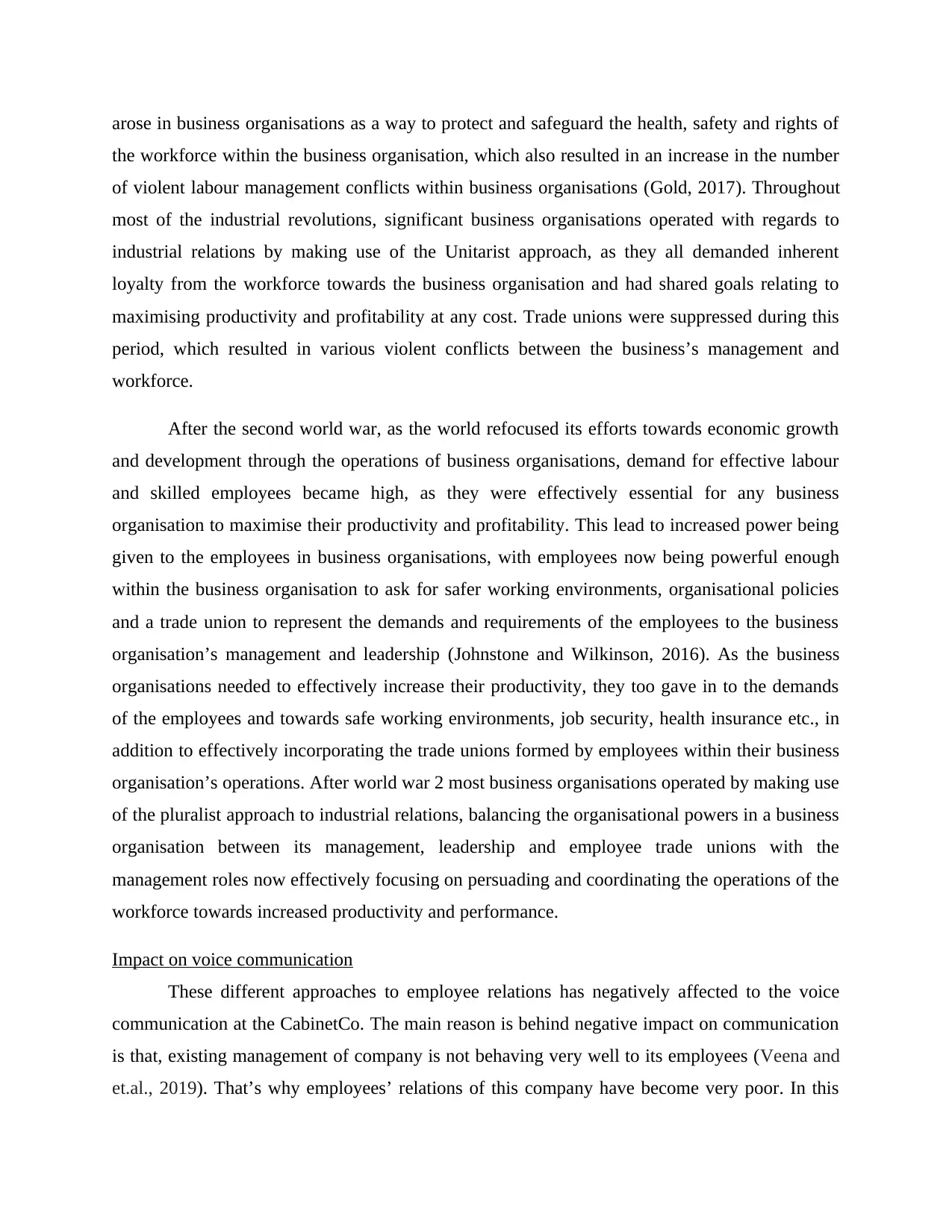
arose in business organisations as a way to protect and safeguard the health, safety and rights of
the workforce within the business organisation, which also resulted in an increase in the number
of violent labour management conflicts within business organisations (Gold, 2017). Throughout
most of the industrial revolutions, significant business organisations operated with regards to
industrial relations by making use of the Unitarist approach, as they all demanded inherent
loyalty from the workforce towards the business organisation and had shared goals relating to
maximising productivity and profitability at any cost. Trade unions were suppressed during this
period, which resulted in various violent conflicts between the business’s management and
workforce.
After the second world war, as the world refocused its efforts towards economic growth
and development through the operations of business organisations, demand for effective labour
and skilled employees became high, as they were effectively essential for any business
organisation to maximise their productivity and profitability. This lead to increased power being
given to the employees in business organisations, with employees now being powerful enough
within the business organisation to ask for safer working environments, organisational policies
and a trade union to represent the demands and requirements of the employees to the business
organisation’s management and leadership (Johnstone and Wilkinson, 2016). As the business
organisations needed to effectively increase their productivity, they too gave in to the demands
of the employees and towards safe working environments, job security, health insurance etc., in
addition to effectively incorporating the trade unions formed by employees within their business
organisation’s operations. After world war 2 most business organisations operated by making use
of the pluralist approach to industrial relations, balancing the organisational powers in a business
organisation between its management, leadership and employee trade unions with the
management roles now effectively focusing on persuading and coordinating the operations of the
workforce towards increased productivity and performance.
Impact on voice communication
These different approaches to employee relations has negatively affected to the voice
communication at the CabinetCo. The main reason is behind negative impact on communication
is that, existing management of company is not behaving very well to its employees (Veena and
et.al., 2019). That’s why employees’ relations of this company have become very poor. In this
the workforce within the business organisation, which also resulted in an increase in the number
of violent labour management conflicts within business organisations (Gold, 2017). Throughout
most of the industrial revolutions, significant business organisations operated with regards to
industrial relations by making use of the Unitarist approach, as they all demanded inherent
loyalty from the workforce towards the business organisation and had shared goals relating to
maximising productivity and profitability at any cost. Trade unions were suppressed during this
period, which resulted in various violent conflicts between the business’s management and
workforce.
After the second world war, as the world refocused its efforts towards economic growth
and development through the operations of business organisations, demand for effective labour
and skilled employees became high, as they were effectively essential for any business
organisation to maximise their productivity and profitability. This lead to increased power being
given to the employees in business organisations, with employees now being powerful enough
within the business organisation to ask for safer working environments, organisational policies
and a trade union to represent the demands and requirements of the employees to the business
organisation’s management and leadership (Johnstone and Wilkinson, 2016). As the business
organisations needed to effectively increase their productivity, they too gave in to the demands
of the employees and towards safe working environments, job security, health insurance etc., in
addition to effectively incorporating the trade unions formed by employees within their business
organisation’s operations. After world war 2 most business organisations operated by making use
of the pluralist approach to industrial relations, balancing the organisational powers in a business
organisation between its management, leadership and employee trade unions with the
management roles now effectively focusing on persuading and coordinating the operations of the
workforce towards increased productivity and performance.
Impact on voice communication
These different approaches to employee relations has negatively affected to the voice
communication at the CabinetCo. The main reason is behind negative impact on communication
is that, existing management of company is not behaving very well to its employees (Veena and
et.al., 2019). That’s why employees’ relations of this company have become very poor. In this
⊘ This is a preview!⊘
Do you want full access?
Subscribe today to unlock all pages.

Trusted by 1+ million students worldwide
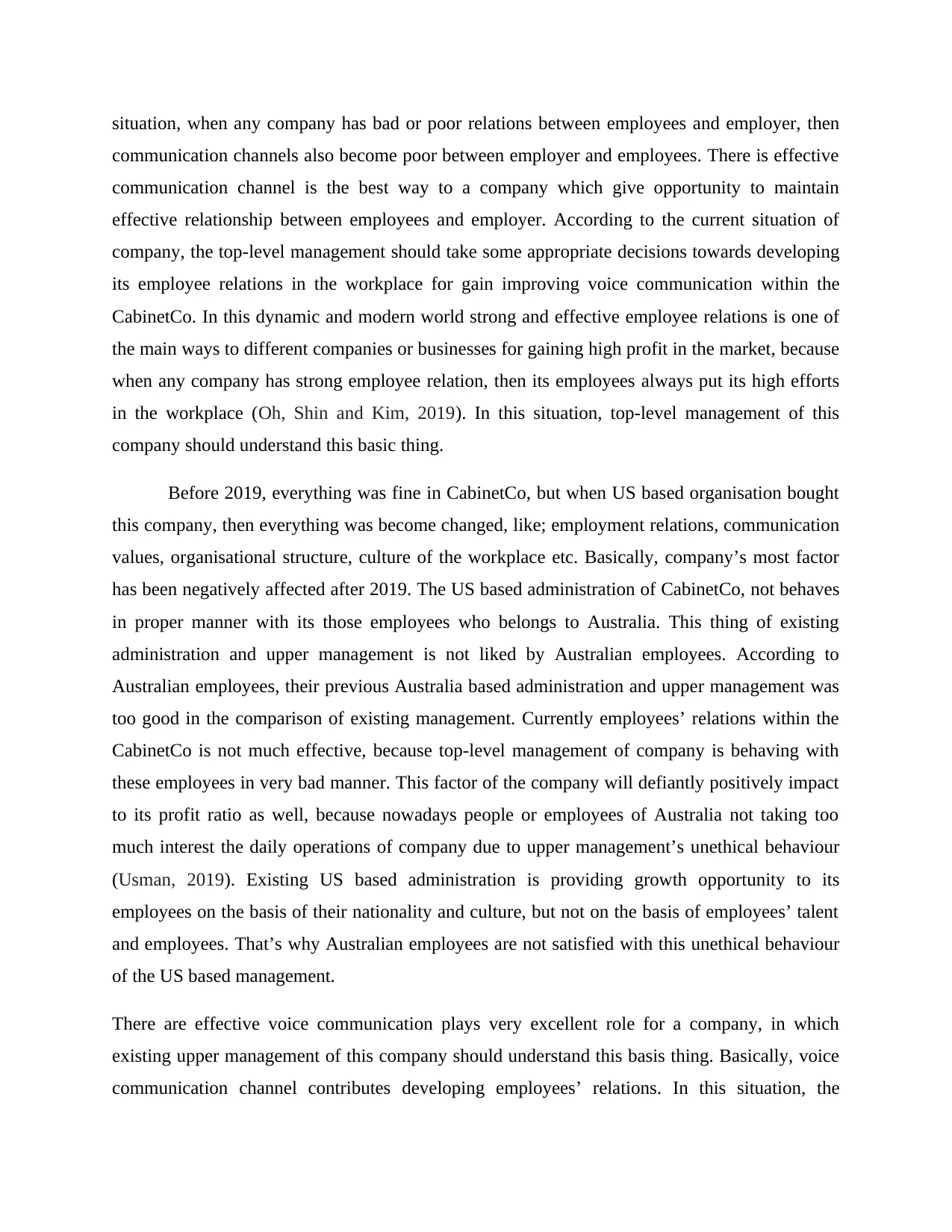
situation, when any company has bad or poor relations between employees and employer, then
communication channels also become poor between employer and employees. There is effective
communication channel is the best way to a company which give opportunity to maintain
effective relationship between employees and employer. According to the current situation of
company, the top-level management should take some appropriate decisions towards developing
its employee relations in the workplace for gain improving voice communication within the
CabinetCo. In this dynamic and modern world strong and effective employee relations is one of
the main ways to different companies or businesses for gaining high profit in the market, because
when any company has strong employee relation, then its employees always put its high efforts
in the workplace (Oh, Shin and Kim, 2019). In this situation, top-level management of this
company should understand this basic thing.
Before 2019, everything was fine in CabinetCo, but when US based organisation bought
this company, then everything was become changed, like; employment relations, communication
values, organisational structure, culture of the workplace etc. Basically, company’s most factor
has been negatively affected after 2019. The US based administration of CabinetCo, not behaves
in proper manner with its those employees who belongs to Australia. This thing of existing
administration and upper management is not liked by Australian employees. According to
Australian employees, their previous Australia based administration and upper management was
too good in the comparison of existing management. Currently employees’ relations within the
CabinetCo is not much effective, because top-level management of company is behaving with
these employees in very bad manner. This factor of the company will defiantly positively impact
to its profit ratio as well, because nowadays people or employees of Australia not taking too
much interest the daily operations of company due to upper management’s unethical behaviour
(Usman, 2019). Existing US based administration is providing growth opportunity to its
employees on the basis of their nationality and culture, but not on the basis of employees’ talent
and employees. That’s why Australian employees are not satisfied with this unethical behaviour
of the US based management.
There are effective voice communication plays very excellent role for a company, in which
existing upper management of this company should understand this basis thing. Basically, voice
communication channel contributes developing employees’ relations. In this situation, the
communication channels also become poor between employer and employees. There is effective
communication channel is the best way to a company which give opportunity to maintain
effective relationship between employees and employer. According to the current situation of
company, the top-level management should take some appropriate decisions towards developing
its employee relations in the workplace for gain improving voice communication within the
CabinetCo. In this dynamic and modern world strong and effective employee relations is one of
the main ways to different companies or businesses for gaining high profit in the market, because
when any company has strong employee relation, then its employees always put its high efforts
in the workplace (Oh, Shin and Kim, 2019). In this situation, top-level management of this
company should understand this basic thing.
Before 2019, everything was fine in CabinetCo, but when US based organisation bought
this company, then everything was become changed, like; employment relations, communication
values, organisational structure, culture of the workplace etc. Basically, company’s most factor
has been negatively affected after 2019. The US based administration of CabinetCo, not behaves
in proper manner with its those employees who belongs to Australia. This thing of existing
administration and upper management is not liked by Australian employees. According to
Australian employees, their previous Australia based administration and upper management was
too good in the comparison of existing management. Currently employees’ relations within the
CabinetCo is not much effective, because top-level management of company is behaving with
these employees in very bad manner. This factor of the company will defiantly positively impact
to its profit ratio as well, because nowadays people or employees of Australia not taking too
much interest the daily operations of company due to upper management’s unethical behaviour
(Usman, 2019). Existing US based administration is providing growth opportunity to its
employees on the basis of their nationality and culture, but not on the basis of employees’ talent
and employees. That’s why Australian employees are not satisfied with this unethical behaviour
of the US based management.
There are effective voice communication plays very excellent role for a company, in which
existing upper management of this company should understand this basis thing. Basically, voice
communication channel contributes developing employees’ relations. In this situation, the
Paraphrase This Document
Need a fresh take? Get an instant paraphrase of this document with our AI Paraphraser
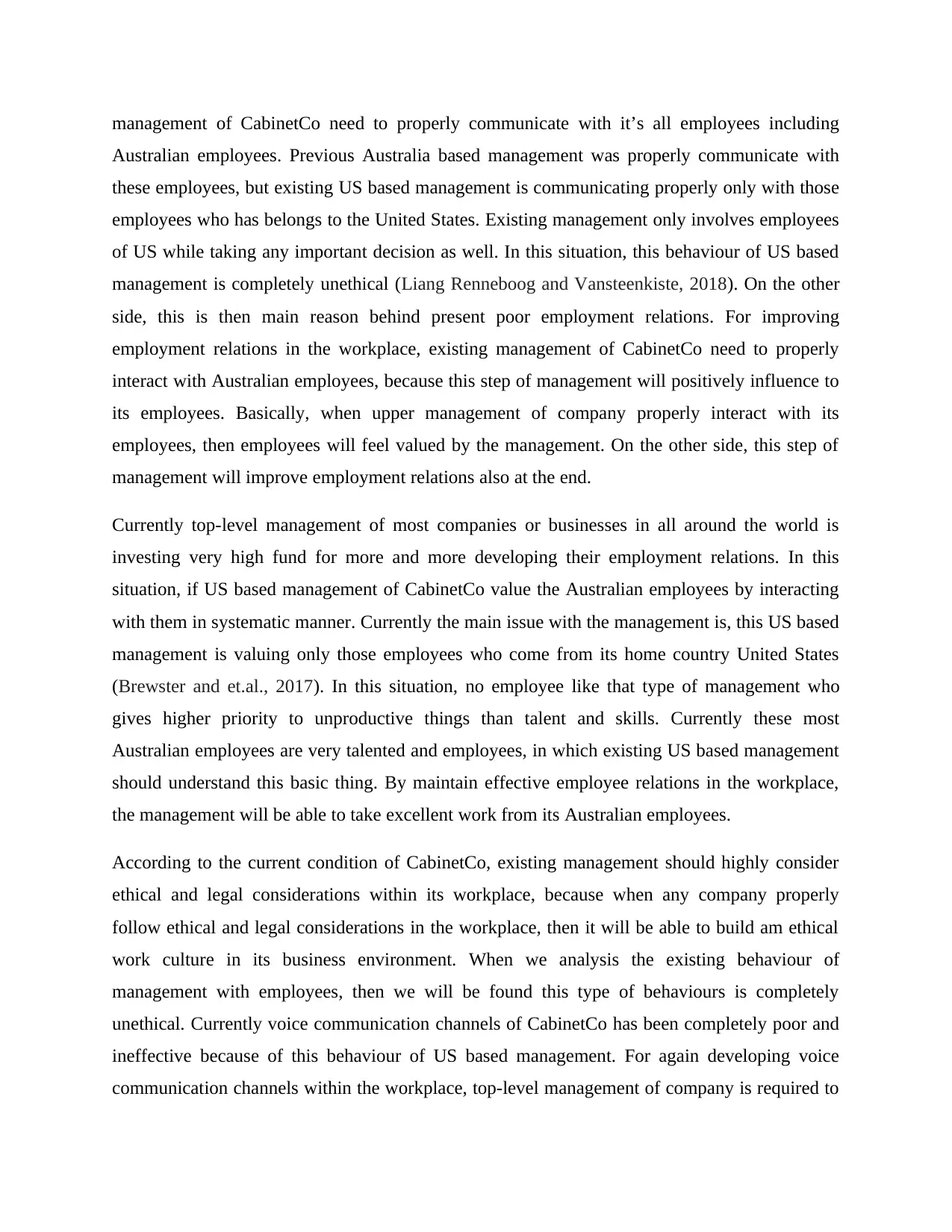
management of CabinetCo need to properly communicate with it’s all employees including
Australian employees. Previous Australia based management was properly communicate with
these employees, but existing US based management is communicating properly only with those
employees who has belongs to the United States. Existing management only involves employees
of US while taking any important decision as well. In this situation, this behaviour of US based
management is completely unethical (Liang Renneboog and Vansteenkiste, 2018). On the other
side, this is then main reason behind present poor employment relations. For improving
employment relations in the workplace, existing management of CabinetCo need to properly
interact with Australian employees, because this step of management will positively influence to
its employees. Basically, when upper management of company properly interact with its
employees, then employees will feel valued by the management. On the other side, this step of
management will improve employment relations also at the end.
Currently top-level management of most companies or businesses in all around the world is
investing very high fund for more and more developing their employment relations. In this
situation, if US based management of CabinetCo value the Australian employees by interacting
with them in systematic manner. Currently the main issue with the management is, this US based
management is valuing only those employees who come from its home country United States
(Brewster and et.al., 2017). In this situation, no employee like that type of management who
gives higher priority to unproductive things than talent and skills. Currently these most
Australian employees are very talented and employees, in which existing US based management
should understand this basic thing. By maintain effective employee relations in the workplace,
the management will be able to take excellent work from its Australian employees.
According to the current condition of CabinetCo, existing management should highly consider
ethical and legal considerations within its workplace, because when any company properly
follow ethical and legal considerations in the workplace, then it will be able to build am ethical
work culture in its business environment. When we analysis the existing behaviour of
management with employees, then we will be found this type of behaviours is completely
unethical. Currently voice communication channels of CabinetCo has been completely poor and
ineffective because of this behaviour of US based management. For again developing voice
communication channels within the workplace, top-level management of company is required to
Australian employees. Previous Australia based management was properly communicate with
these employees, but existing US based management is communicating properly only with those
employees who has belongs to the United States. Existing management only involves employees
of US while taking any important decision as well. In this situation, this behaviour of US based
management is completely unethical (Liang Renneboog and Vansteenkiste, 2018). On the other
side, this is then main reason behind present poor employment relations. For improving
employment relations in the workplace, existing management of CabinetCo need to properly
interact with Australian employees, because this step of management will positively influence to
its employees. Basically, when upper management of company properly interact with its
employees, then employees will feel valued by the management. On the other side, this step of
management will improve employment relations also at the end.
Currently top-level management of most companies or businesses in all around the world is
investing very high fund for more and more developing their employment relations. In this
situation, if US based management of CabinetCo value the Australian employees by interacting
with them in systematic manner. Currently the main issue with the management is, this US based
management is valuing only those employees who come from its home country United States
(Brewster and et.al., 2017). In this situation, no employee like that type of management who
gives higher priority to unproductive things than talent and skills. Currently these most
Australian employees are very talented and employees, in which existing US based management
should understand this basic thing. By maintain effective employee relations in the workplace,
the management will be able to take excellent work from its Australian employees.
According to the current condition of CabinetCo, existing management should highly consider
ethical and legal considerations within its workplace, because when any company properly
follow ethical and legal considerations in the workplace, then it will be able to build am ethical
work culture in its business environment. When we analysis the existing behaviour of
management with employees, then we will be found this type of behaviours is completely
unethical. Currently voice communication channels of CabinetCo has been completely poor and
ineffective because of this behaviour of US based management. For again developing voice
communication channels within the workplace, top-level management of company is required to
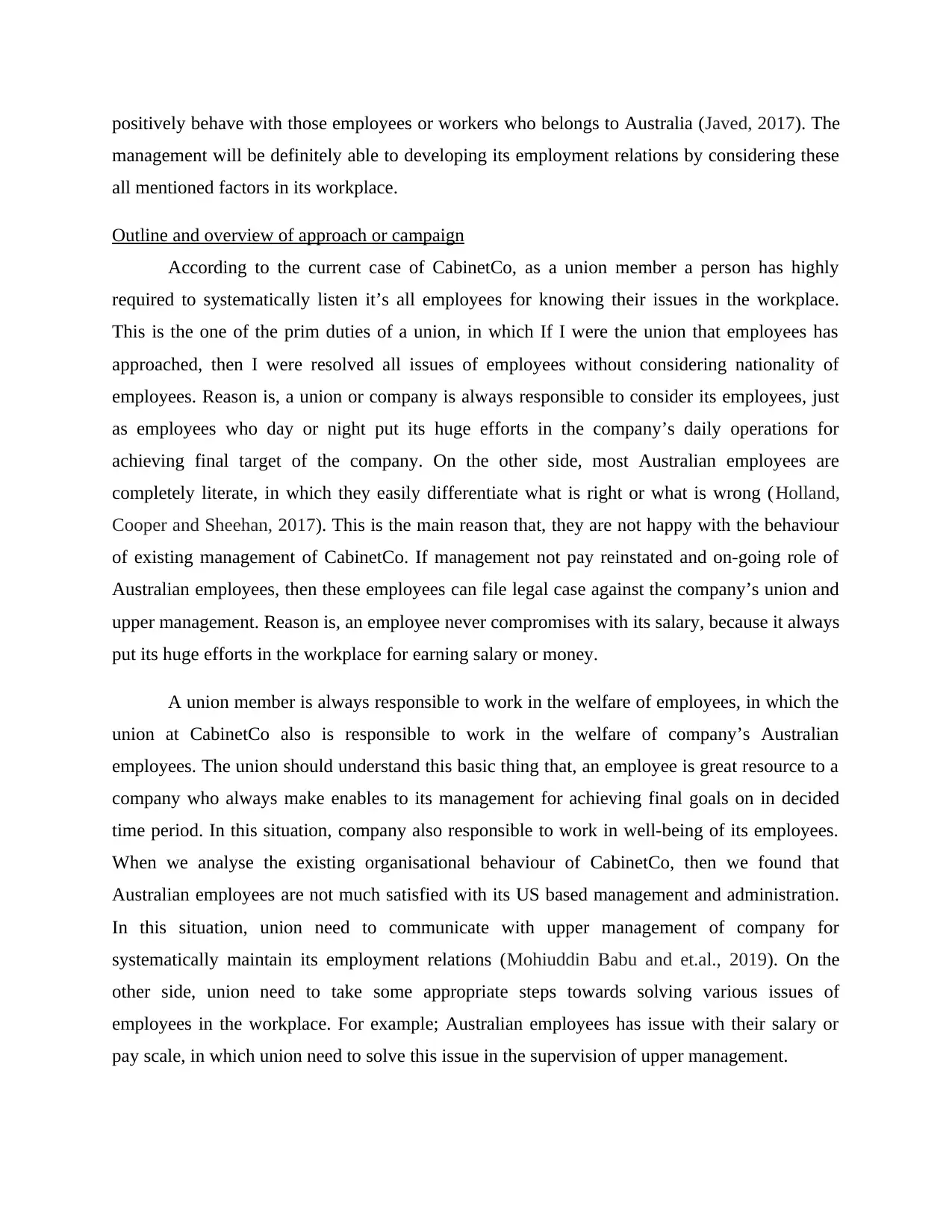
positively behave with those employees or workers who belongs to Australia (Javed, 2017). The
management will be definitely able to developing its employment relations by considering these
all mentioned factors in its workplace.
Outline and overview of approach or campaign
According to the current case of CabinetCo, as a union member a person has highly
required to systematically listen it’s all employees for knowing their issues in the workplace.
This is the one of the prim duties of a union, in which If I were the union that employees has
approached, then I were resolved all issues of employees without considering nationality of
employees. Reason is, a union or company is always responsible to consider its employees, just
as employees who day or night put its huge efforts in the company’s daily operations for
achieving final target of the company. On the other side, most Australian employees are
completely literate, in which they easily differentiate what is right or what is wrong (Holland,
Cooper and Sheehan, 2017). This is the main reason that, they are not happy with the behaviour
of existing management of CabinetCo. If management not pay reinstated and on-going role of
Australian employees, then these employees can file legal case against the company’s union and
upper management. Reason is, an employee never compromises with its salary, because it always
put its huge efforts in the workplace for earning salary or money.
A union member is always responsible to work in the welfare of employees, in which the
union at CabinetCo also is responsible to work in the welfare of company’s Australian
employees. The union should understand this basic thing that, an employee is great resource to a
company who always make enables to its management for achieving final goals on in decided
time period. In this situation, company also responsible to work in well-being of its employees.
When we analyse the existing organisational behaviour of CabinetCo, then we found that
Australian employees are not much satisfied with its US based management and administration.
In this situation, union need to communicate with upper management of company for
systematically maintain its employment relations (Mohiuddin Babu and et.al., 2019). On the
other side, union need to take some appropriate steps towards solving various issues of
employees in the workplace. For example; Australian employees has issue with their salary or
pay scale, in which union need to solve this issue in the supervision of upper management.
management will be definitely able to developing its employment relations by considering these
all mentioned factors in its workplace.
Outline and overview of approach or campaign
According to the current case of CabinetCo, as a union member a person has highly
required to systematically listen it’s all employees for knowing their issues in the workplace.
This is the one of the prim duties of a union, in which If I were the union that employees has
approached, then I were resolved all issues of employees without considering nationality of
employees. Reason is, a union or company is always responsible to consider its employees, just
as employees who day or night put its huge efforts in the company’s daily operations for
achieving final target of the company. On the other side, most Australian employees are
completely literate, in which they easily differentiate what is right or what is wrong (Holland,
Cooper and Sheehan, 2017). This is the main reason that, they are not happy with the behaviour
of existing management of CabinetCo. If management not pay reinstated and on-going role of
Australian employees, then these employees can file legal case against the company’s union and
upper management. Reason is, an employee never compromises with its salary, because it always
put its huge efforts in the workplace for earning salary or money.
A union member is always responsible to work in the welfare of employees, in which the
union at CabinetCo also is responsible to work in the welfare of company’s Australian
employees. The union should understand this basic thing that, an employee is great resource to a
company who always make enables to its management for achieving final goals on in decided
time period. In this situation, company also responsible to work in well-being of its employees.
When we analyse the existing organisational behaviour of CabinetCo, then we found that
Australian employees are not much satisfied with its US based management and administration.
In this situation, union need to communicate with upper management of company for
systematically maintain its employment relations (Mohiuddin Babu and et.al., 2019). On the
other side, union need to take some appropriate steps towards solving various issues of
employees in the workplace. For example; Australian employees has issue with their salary or
pay scale, in which union need to solve this issue in the supervision of upper management.
⊘ This is a preview!⊘
Do you want full access?
Subscribe today to unlock all pages.

Trusted by 1+ million students worldwide
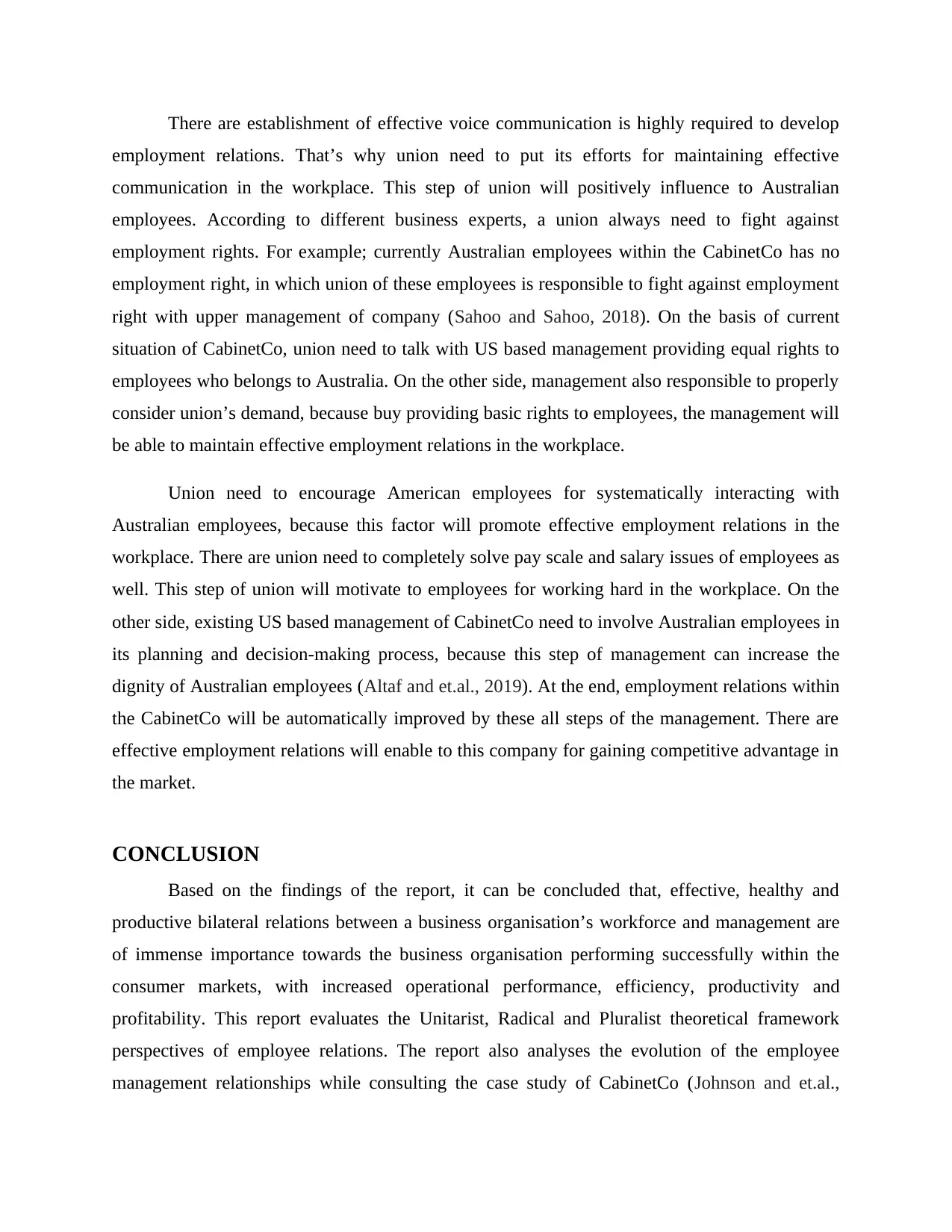
There are establishment of effective voice communication is highly required to develop
employment relations. That’s why union need to put its efforts for maintaining effective
communication in the workplace. This step of union will positively influence to Australian
employees. According to different business experts, a union always need to fight against
employment rights. For example; currently Australian employees within the CabinetCo has no
employment right, in which union of these employees is responsible to fight against employment
right with upper management of company (Sahoo and Sahoo, 2018). On the basis of current
situation of CabinetCo, union need to talk with US based management providing equal rights to
employees who belongs to Australia. On the other side, management also responsible to properly
consider union’s demand, because buy providing basic rights to employees, the management will
be able to maintain effective employment relations in the workplace.
Union need to encourage American employees for systematically interacting with
Australian employees, because this factor will promote effective employment relations in the
workplace. There are union need to completely solve pay scale and salary issues of employees as
well. This step of union will motivate to employees for working hard in the workplace. On the
other side, existing US based management of CabinetCo need to involve Australian employees in
its planning and decision-making process, because this step of management can increase the
dignity of Australian employees (Altaf and et.al., 2019). At the end, employment relations within
the CabinetCo will be automatically improved by these all steps of the management. There are
effective employment relations will enable to this company for gaining competitive advantage in
the market.
CONCLUSION
Based on the findings of the report, it can be concluded that, effective, healthy and
productive bilateral relations between a business organisation’s workforce and management are
of immense importance towards the business organisation performing successfully within the
consumer markets, with increased operational performance, efficiency, productivity and
profitability. This report evaluates the Unitarist, Radical and Pluralist theoretical framework
perspectives of employee relations. The report also analyses the evolution of the employee
management relationships while consulting the case study of CabinetCo (Johnson and et.al.,
employment relations. That’s why union need to put its efforts for maintaining effective
communication in the workplace. This step of union will positively influence to Australian
employees. According to different business experts, a union always need to fight against
employment rights. For example; currently Australian employees within the CabinetCo has no
employment right, in which union of these employees is responsible to fight against employment
right with upper management of company (Sahoo and Sahoo, 2018). On the basis of current
situation of CabinetCo, union need to talk with US based management providing equal rights to
employees who belongs to Australia. On the other side, management also responsible to properly
consider union’s demand, because buy providing basic rights to employees, the management will
be able to maintain effective employment relations in the workplace.
Union need to encourage American employees for systematically interacting with
Australian employees, because this factor will promote effective employment relations in the
workplace. There are union need to completely solve pay scale and salary issues of employees as
well. This step of union will motivate to employees for working hard in the workplace. On the
other side, existing US based management of CabinetCo need to involve Australian employees in
its planning and decision-making process, because this step of management can increase the
dignity of Australian employees (Altaf and et.al., 2019). At the end, employment relations within
the CabinetCo will be automatically improved by these all steps of the management. There are
effective employment relations will enable to this company for gaining competitive advantage in
the market.
CONCLUSION
Based on the findings of the report, it can be concluded that, effective, healthy and
productive bilateral relations between a business organisation’s workforce and management are
of immense importance towards the business organisation performing successfully within the
consumer markets, with increased operational performance, efficiency, productivity and
profitability. This report evaluates the Unitarist, Radical and Pluralist theoretical framework
perspectives of employee relations. The report also analyses the evolution of the employee
management relationships while consulting the case study of CabinetCo (Johnson and et.al.,
Paraphrase This Document
Need a fresh take? Get an instant paraphrase of this document with our AI Paraphraser

2018). Further the report assesses the ways in which different approaches to employee relations
at CabinetCo have influenced and affected its voice communication channels. Finally, the report
examines role and approach of union towards reinstating the pay of CabinetCo’s employees.
at CabinetCo have influenced and affected its voice communication channels. Finally, the report
examines role and approach of union towards reinstating the pay of CabinetCo’s employees.
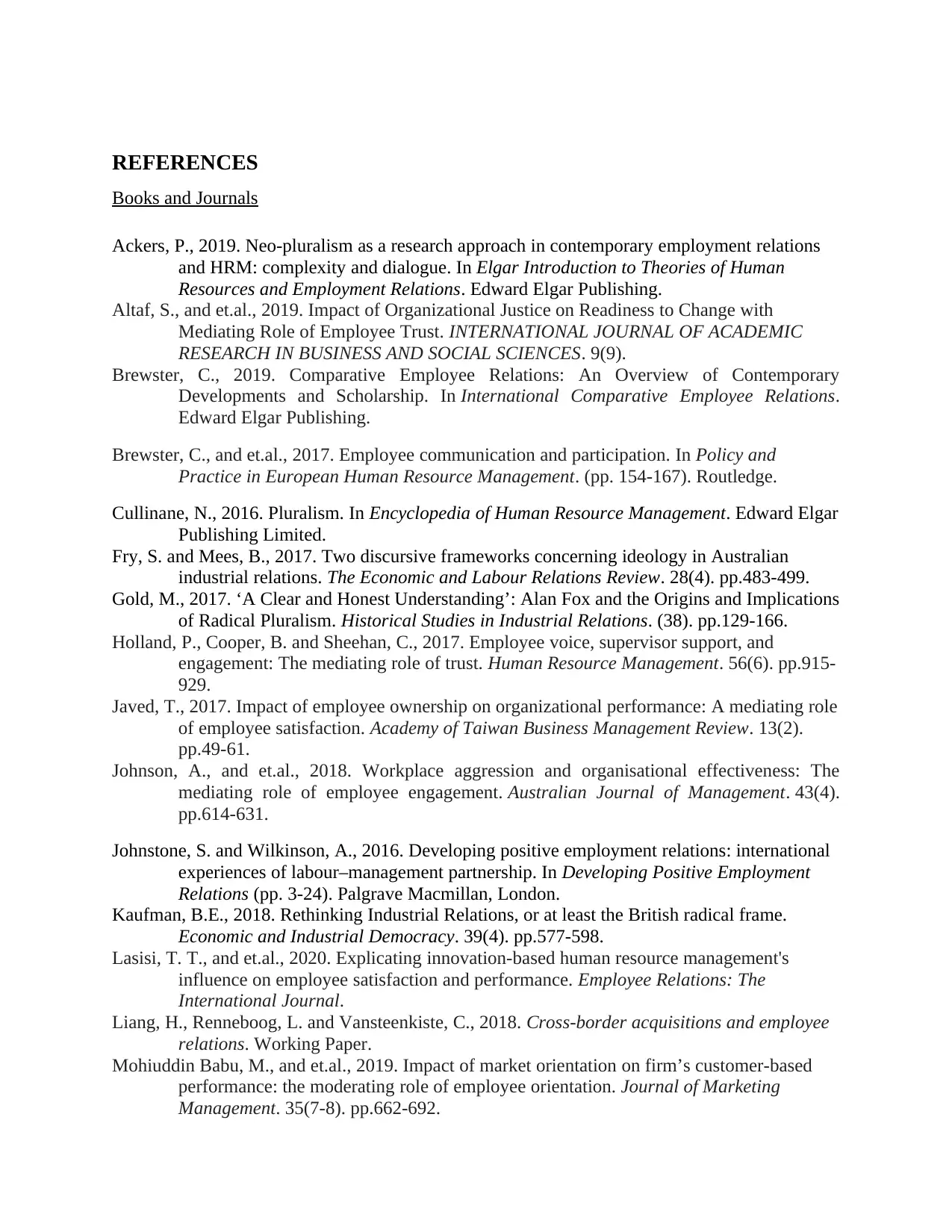
REFERENCES
Books and Journals
Ackers, P., 2019. Neo-pluralism as a research approach in contemporary employment relations
and HRM: complexity and dialogue. In Elgar Introduction to Theories of Human
Resources and Employment Relations. Edward Elgar Publishing.
Altaf, S., and et.al., 2019. Impact of Organizational Justice on Readiness to Change with
Mediating Role of Employee Trust. INTERNATIONAL JOURNAL OF ACADEMIC
RESEARCH IN BUSINESS AND SOCIAL SCIENCES. 9(9).
Brewster, C., 2019. Comparative Employee Relations: An Overview of Contemporary
Developments and Scholarship. In International Comparative Employee Relations.
Edward Elgar Publishing.
Brewster, C., and et.al., 2017. Employee communication and participation. In Policy and
Practice in European Human Resource Management. (pp. 154-167). Routledge.
Cullinane, N., 2016. Pluralism. In Encyclopedia of Human Resource Management. Edward Elgar
Publishing Limited.
Fry, S. and Mees, B., 2017. Two discursive frameworks concerning ideology in Australian
industrial relations. The Economic and Labour Relations Review. 28(4). pp.483-499.
Gold, M., 2017. ‘A Clear and Honest Understanding’: Alan Fox and the Origins and Implications
of Radical Pluralism. Historical Studies in Industrial Relations. (38). pp.129-166.
Holland, P., Cooper, B. and Sheehan, C., 2017. Employee voice, supervisor support, and
engagement: The mediating role of trust. Human Resource Management. 56(6). pp.915-
929.
Javed, T., 2017. Impact of employee ownership on organizational performance: A mediating role
of employee satisfaction. Academy of Taiwan Business Management Review. 13(2).
pp.49-61.
Johnson, A., and et.al., 2018. Workplace aggression and organisational effectiveness: The
mediating role of employee engagement. Australian Journal of Management. 43(4).
pp.614-631.
Johnstone, S. and Wilkinson, A., 2016. Developing positive employment relations: international
experiences of labour–management partnership. In Developing Positive Employment
Relations (pp. 3-24). Palgrave Macmillan, London.
Kaufman, B.E., 2018. Rethinking Industrial Relations, or at least the British radical frame.
Economic and Industrial Democracy. 39(4). pp.577-598.
Lasisi, T. T., and et.al., 2020. Explicating innovation-based human resource management's
influence on employee satisfaction and performance. Employee Relations: The
International Journal.
Liang, H., Renneboog, L. and Vansteenkiste, C., 2018. Cross-border acquisitions and employee
relations. Working Paper.
Mohiuddin Babu, M., and et.al., 2019. Impact of market orientation on firm’s customer-based
performance: the moderating role of employee orientation. Journal of Marketing
Management. 35(7-8). pp.662-692.
Books and Journals
Ackers, P., 2019. Neo-pluralism as a research approach in contemporary employment relations
and HRM: complexity and dialogue. In Elgar Introduction to Theories of Human
Resources and Employment Relations. Edward Elgar Publishing.
Altaf, S., and et.al., 2019. Impact of Organizational Justice on Readiness to Change with
Mediating Role of Employee Trust. INTERNATIONAL JOURNAL OF ACADEMIC
RESEARCH IN BUSINESS AND SOCIAL SCIENCES. 9(9).
Brewster, C., 2019. Comparative Employee Relations: An Overview of Contemporary
Developments and Scholarship. In International Comparative Employee Relations.
Edward Elgar Publishing.
Brewster, C., and et.al., 2017. Employee communication and participation. In Policy and
Practice in European Human Resource Management. (pp. 154-167). Routledge.
Cullinane, N., 2016. Pluralism. In Encyclopedia of Human Resource Management. Edward Elgar
Publishing Limited.
Fry, S. and Mees, B., 2017. Two discursive frameworks concerning ideology in Australian
industrial relations. The Economic and Labour Relations Review. 28(4). pp.483-499.
Gold, M., 2017. ‘A Clear and Honest Understanding’: Alan Fox and the Origins and Implications
of Radical Pluralism. Historical Studies in Industrial Relations. (38). pp.129-166.
Holland, P., Cooper, B. and Sheehan, C., 2017. Employee voice, supervisor support, and
engagement: The mediating role of trust. Human Resource Management. 56(6). pp.915-
929.
Javed, T., 2017. Impact of employee ownership on organizational performance: A mediating role
of employee satisfaction. Academy of Taiwan Business Management Review. 13(2).
pp.49-61.
Johnson, A., and et.al., 2018. Workplace aggression and organisational effectiveness: The
mediating role of employee engagement. Australian Journal of Management. 43(4).
pp.614-631.
Johnstone, S. and Wilkinson, A., 2016. Developing positive employment relations: international
experiences of labour–management partnership. In Developing Positive Employment
Relations (pp. 3-24). Palgrave Macmillan, London.
Kaufman, B.E., 2018. Rethinking Industrial Relations, or at least the British radical frame.
Economic and Industrial Democracy. 39(4). pp.577-598.
Lasisi, T. T., and et.al., 2020. Explicating innovation-based human resource management's
influence on employee satisfaction and performance. Employee Relations: The
International Journal.
Liang, H., Renneboog, L. and Vansteenkiste, C., 2018. Cross-border acquisitions and employee
relations. Working Paper.
Mohiuddin Babu, M., and et.al., 2019. Impact of market orientation on firm’s customer-based
performance: the moderating role of employee orientation. Journal of Marketing
Management. 35(7-8). pp.662-692.
⊘ This is a preview!⊘
Do you want full access?
Subscribe today to unlock all pages.

Trusted by 1+ million students worldwide
1 out of 13
Related Documents
Your All-in-One AI-Powered Toolkit for Academic Success.
+13062052269
info@desklib.com
Available 24*7 on WhatsApp / Email
![[object Object]](/_next/static/media/star-bottom.7253800d.svg)
Unlock your academic potential
Copyright © 2020–2025 A2Z Services. All Rights Reserved. Developed and managed by ZUCOL.





